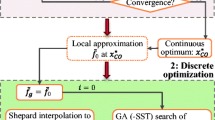Abstract
The bending deflections and the corresponding optimal fiber angle sequences of the subsequent layers have been predicted in this article using a hybrid technique. The structural static responses are computed numerically via the isoparametric finite element steps in association with Reddy’s higher order mid-plane theory. The final stacking sequences of individual layers are further predicted through two types of soft computing techniques (particle swarm optimization, PSO; teaching–learning-based optimization, TLBO). The responses (deflection and optimal angle) are obtained via a customized computer code (MATLAB) using the current mathematical model in association with two different optimization algorithms. The accuracy of the currently derived higher order hybrid model is established by conducting a few numerical experimentations. The study indicates the superiority of TLBO technique over PSO for any particular problem when compared to the minimum deflection constraint whereas not many deviations for stacking sequences. Finally, the influences of the different structural parameter are explored by solving a variety of numerical examples and the corresponding inferences provided in detail.






Similar content being viewed by others
References
Kennedy J, Eberhart RC (1995) Particle swarm optimization. In: Proceedings of IEEE international conference on neural networks. Perth, Australia, pp 1942–1948. https://doi.org/10.1109/ICNN.1995.488968
Shi Y, Eberhart RC (1998) A modified particle swarm optimizer. In: 1998 IEEE international conference on evolutionary computation proceedings, IEEE world congress on computational intelligence (Cat. No. 98TH8360), Anchorage, AK, USA, pp 69–73. https://doi.org/10.1109/ICEC.1998.699146
Kennedy J (1997) The particle swarm: social adaptation of knowledge. In: Proceedings of 1997 IEEE international conference on evolutionary computation (ICEC’97), pp 303–308
Kennedy J, Eberhart RC (2001) Swarm intelligence. Morgan Kaufmann 978-1-55860-595-4
Poli R (2007) An analysis of publications on particle swarm optimisation applications. 1st edn. Morgan Kaufmann Publishers, San Francisco, CA, USA
Poli R (2008) Analysis of the publications on the applications of particle swarm optimisation. J Artif Evol Appl. https://doi.org/10.1155/2008/685175
Bonyadi MR, Michalewicz Z (2017) Particle swarm optimization for single objective continuous space problems: a review. Evol Comput 25(1):1–54. https://doi.org/10.1162/evco_r_00180
Sengupta S, Basak S, Peters RA II (2018) Particle swarm optimization: a survey of historical and recent developments with hybridization perspectives. Mach Learn Knowl Extr 1(1):157–191. https://doi.org/10.3390/make1010010
Manjunath K, Rangaswamy T (2014) Ply stacking sequence optimization of composite driveshaft using particle swarm optimization algorithm. Int J Simul Multidiscip Des Optim 5:A16
Bargh HG, Sadr M (2012) H, Stacking sequence optimization of composite plates for maximum fundamental frequency using particle swarm optimization algorithm. Meccanica 47(3):719–730
Manjunath K, Kumar SM, Channakeshava K (2011) R, Optimization of ply stacking sequence of composite drive shaft using particle swarm algorithm. J Eng Sci Technol 6(3):323–331
Zadeh PM, Fakoor M, Mohagheghi M (2018) Bi-level optimization of laminated composite structures using particle swarm optimization algorithm. J Mech Sci Technol 32(4):1643–1652
Chen J, Tang Y, Ge R, An Q, Guo X (2013) Reliability design optimization of composite structures based on PSO together with FEA. Chin J Aeronaut 26(2):343–349
Kolahchi R, Keshtegar B, Fakhar MH (2017) Optimization of dynamic buckling for sandwich nanocomposite plates with sensor and actuator layer based on sinusoidal-visco-piezoelasticity theories using Grey Wolf algorithm. J Sandw Struct Mater. https://doi.org/10.1177/1099636217731071
Rao RV, Savsani VJ, Vakharia DP (2011) Teaching-learning-based optimization: a novel method for constrained mechanical design optimization problems. CAD Comput Aided Des 43:303–315
Temur R, Bekdaş G (2016) Teaching learning-based optimization for design of cantilever retaining walls. Struct Eng Mech 57(4):763–783
Sayare RS, Kamble AG (2015) Parameter Optimization of Composite Leaf Spring Using TLBO Algorithm. Int Eng Res J 2:4358–4364
Topal U, Dede T, Öztürk HT (2017) Stacking sequence optimization for maximum fundamental frequency of simply supported antisymmetric laminated composite plates using teaching–learning-based optimization. KSCE J Civ Eng 21(6):2281–2288
Rao RV, Rai DP, Balic J (2018) Multi-objective optimization of machining and micro-machining processes using non-dominated sorting teaching–learning-based optimization algorithm. J Intell Manuf 29(8):1715–1737
Rao RV, Kalyankar V (2013) D, Parameter optimization of modern machining processes using teaching–learning-based optimization algorithm. Eng Appl Artif Intell 26(1):524–531
Ghannadpour SA (2018) M, Ritz method application to bending, buckling and vibration analyses of Timoshenko beams via nonlocal elasticity. J Appl Comput Mech 4(1):16–26
Ghannadpour SAM, Mohammadi B, Fazilati J (2013) Bending, buckling and vibration problems of nonlocal Euler beams using Ritz method. Compos Struct 96:584–589
Kolahchi R (2017) A comparative study on the bending, vibration and buckling of viscoelastic sandwich nano-plates based on different nonlocal theories using DC, HDQ and DQ methods. Aerosp Sci Technol 66:235–248
Kolahchi R, Bidgoli AMM, Heydari MM (2015) Size-dependent bending analysis of FGM nano-sinusoidal plates resting on orthotropic elastic medium. Struct Eng Mech 55(5):1001–1014
Civalek Ö, Demir Ç (2011) Bending analysis of microtubules using nonlocal Euler-Bernoulli beam theory. Appl Math Model 35(5):2053–2067
Civalek Ö, Demir C (2011) Buckling and bending analyses of cantilever carbon nanotubes using the Euler-Bernoulli beam theory based on non-local continuum model. Asian J Civ Eng 12(5):651–661
Patle BK, Hirwani CK, Singh RP, Panda SK (2018) Eigenfrequency and deflection analysis of layered structure using uncertain elastic properties—a fuzzy finite element approach. Int J Approx Reason 98:163–176
Jones RM (1999) Mechanics of composite materials. Taylor & Francis, Philadelphia
Cook RD, Malkus DS, Plesha ME, Witt RJ (2003) Concepts and applications of finite element analysis. Willy, Singapore
Yousuf LS, Hade APDNH (2011) Stacking sequence optimization based on deflection and stress using genetic algorithms and finite difference for simply supported square laminate plate under uniform distributed load. Alnahrain J Eng Sci 14(2):137–148
Author information
Authors and Affiliations
Corresponding author
Ethics declarations
Conflict of interest
On behalf of all authors, the corresponding author states that there is no conflict of interest.
Additional information
Publisher's Note
Springer Nature remains neutral with regard to jurisdictional claims in published maps and institutional affiliations.
Rights and permissions
About this article
Cite this article
Sharma, N., Lalepalli, A.K., Hirwani, C.K. et al. Optimal deflection and stacking sequence prediction of curved composite structure using hybrid (FEM and soft computing) technique. Engineering with Computers 37, 477–487 (2021). https://doi.org/10.1007/s00366-019-00836-8
Received:
Accepted:
Published:
Issue Date:
DOI: https://doi.org/10.1007/s00366-019-00836-8



